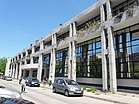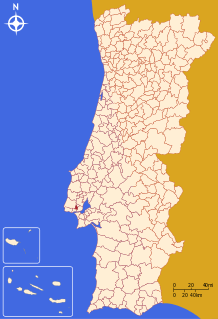Amadora
Amadora (Portuguese pronunciation: [ɐmɐˈðoɾɐ] (![]()
Amadora | |
|---|---|
.jpg) .jpg) .jpg) _(cropped).jpg) .jpg)  | |
 Flag  Coat of arms | |
 | |
| Coordinates: 38°44′N 9°14′W | |
| Country | |
| Region | Lisboa |
| Metropolitan area | Lisbon |
| District | Lisbon |
| Parishes | 6 |
| Government | |
| • President | Carla Tavares (PS) |
| Area | |
| • Total | 23.78 km2 (9.18 sq mi) |
| Population (2011) | |
| • Total | 175,136 |
| • Density | 7,400/km2 (19,000/sq mi) |
| Time zone | UTC±00:00 (WET) |
| • Summer (DST) | UTC+01:00 (WEST) |
| Website | http://www.cm-amadora.pt |
History
There is significant evidence of Neolithic settlements in the municipality. The Necropolis of Carenque consists of three artificial caves that served as tombs from around 3000 BCE.
Originally named Porcalhota, for being a Majorat of the daughter of a man surnamed Porcalho who was called for being a female Porcalhota.
The Aqueduto das Águas Livres, which brings water from the Sintra hills to Lisbon, and stretches 30 kilometres (19 mi), was finished in the 1770s and includes the largest masonry arch ever built, located in Campolide — the local coat of arms also displays the aqueduct (like others along its way).
At the request of its population, in 1907, a decree issued during King Carlos I reign, merged the communities of Porcalhota, Amadora and Venteira into one town named Amadora.
At the present time Amadora does not have any airfield. However, in the 1920s a small airfield (the first in Portugal) was located here. The first flight from Portugal to Brazil left from Amadora. The Captain of the airplane was Adm. Gago Coutinho, a well known Portuguese celebrity.
The municipality was formed on 11 September 1979, when it ceased being a parish of the municipality of Oeiras. Few days later, on 17 September, Amadora was granted city status.
The former Sorefame railway rolling stock factory was located in Amadora, but was closed in 2004. Most of the carriages for Portuguese Railways built during the second half of the 20th century were constructed here.
Geography
One of the largest urban communities in Portugal, Amadora forms a conurbation with Lisbon, sharing the same subway, bus and train networks. It is dominated by large apartment blocks, commercial parks, industrial areas and some headquarters of international companies.
Administratively, the municipality is divided into 6 civil parishes (freguesias):[3]
- Águas Livres
- Alfragide
- Encosta do Sol
- Falagueira-Venda Nova
- Mina de Água
- Venteira
Economy
Despite being essentially a residential city, Amadora has commercial zones, industries and headquarters of international companies operating in Portugal.
As commercial zones, it has IKEA, Nokia, Decathlon, Alegro, Continente and Dolce Vita Tejo (one of the biggest shopping malls in Europe). Siemens and Roche are examples of international companies based in Amadora.
Transport
Amadora's public transport network is extremely far-reaching and reliable, being fully integrated with the transportation network of the Lisbon metropolitan area. It has 3 metro stations, the commuter Sintra train line with 3 stations, 2 bus services (Vimeca and Carris) and 4 motorways around the city (2ª Circular, CRIL, CREL and IC-16).
Gallery
- CRIL (Circular Regional Interior de Lisboa) in Amadora, Lisbon
 Condos in the parish of Alfragide
Condos in the parish of Alfragide Centro Ciência Viva da Amadora, Lisbon
Centro Ciência Viva da Amadora, Lisbon Amadora, Lisbon Region
Amadora, Lisbon Region Damaia Main Train Station, Amadora
Damaia Main Train Station, Amadora Amadora, Lisbon
Amadora, Lisbon- Lisbon Metro in Alfornelos, Amadora
Culture
Every year, Amadora city organizes the Amadora International Comics Festival.[4]
See also
References
- Instituto Nacional de Estatística
- "Áreas das freguesias, concelhos, distritos e país". Archived from the original on 2018-11-05. Retrieved 2018-11-05.
- Diário da República. "Law nr. 11-A/2013, page 552 13" (pdf) (in Portuguese). Retrieved 16 July 2014.
- Amadora International Comics Festival official website. Accessed July 5, 2017.
External links
- Amadora International Comics Festival - official festival Web site
- Photos from AMADORA
- - media information